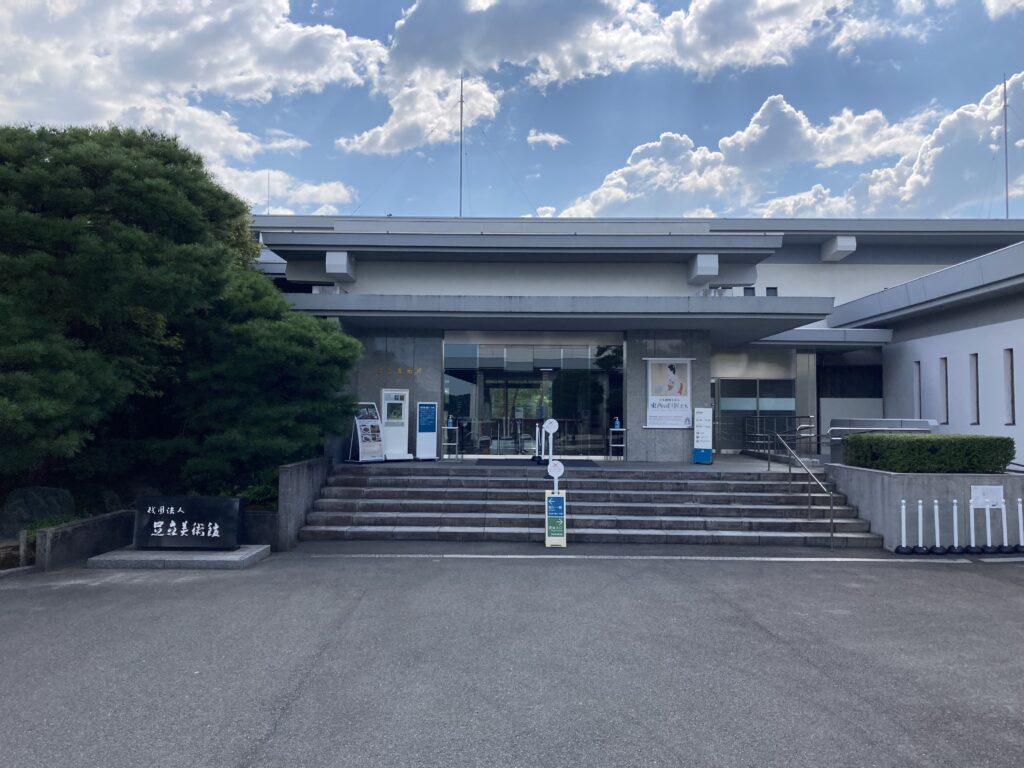
What Is the Adachi Museum of Art?
Located in Yasugi, Shimane Prefecture, the Adachi Museum of Art is a unique art museum where the garden takes center stage. And this garden is no ordinary one.
It has been ranked the best Japanese garden in the country for over 20 consecutive years since 2003 by the American magazine The Journal of Japanese Gardening.
So, what makes this world-famous garden so special?
Let’s take a closer look at the Adachi Museum of Art—home to Japan’s most beautiful garden.
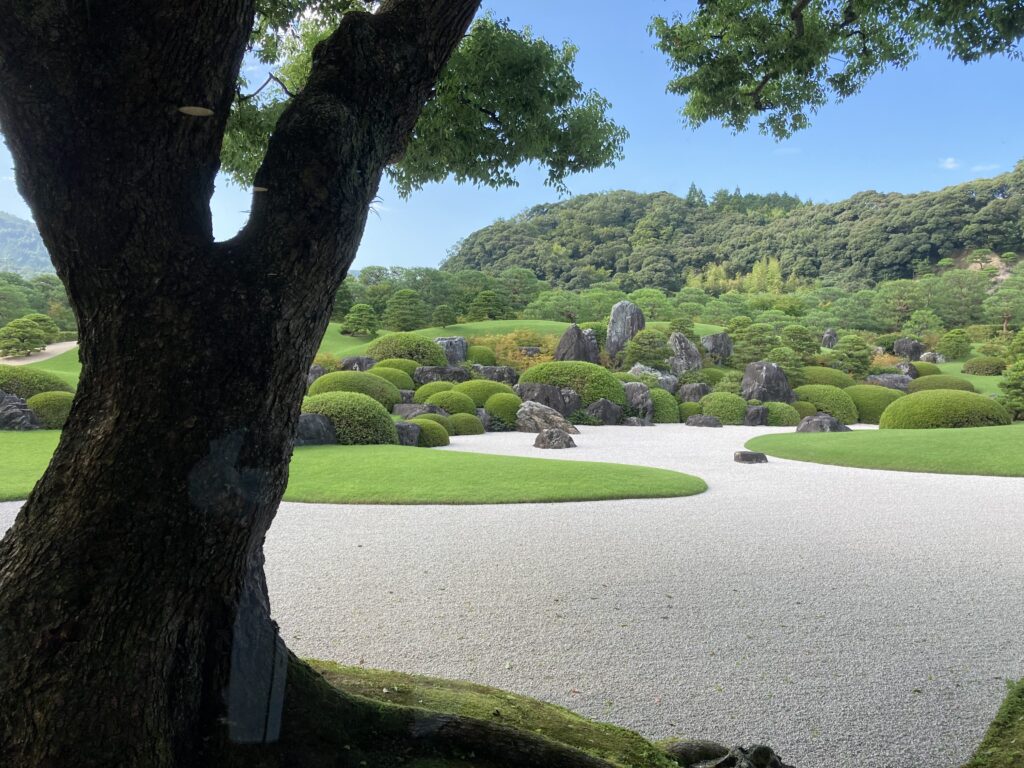
A Garden That Blends into the Local Landscape
The museum is located in the city of Yasugi. Legend says that the Shinto god Susanoo-no-Mikoto felt a sense of peace when visiting this area, giving it the name “Yasugi,” meaning “to feel at ease.” It’s also said to have inspired settings in the famous Studio Ghibli film Princess Mononoke.
This is a region rich in history and surrounded by breathtaking nature.
The museum’s garden takes full advantage of this setting. A key feature is how it blends seamlessly with the natural surroundings.
One example is Mount Katsuyama, visible from the garden. During the Warring States period, the Mōri clan used this mountain as a military base. Now, it provides a scenic backdrop that enhances the entire garden view.
This style of incorporating the surrounding landscape—known as shakkei or “borrowed scenery”—is one reason the Adachi Museum’s garden is held in such high regard.
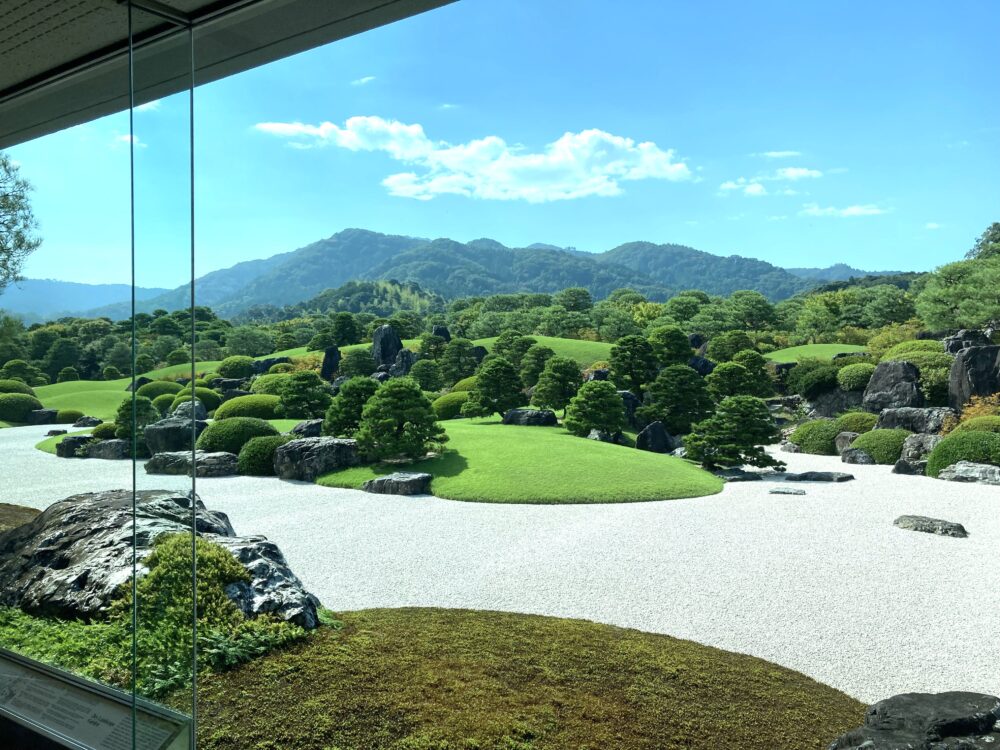
Japan’s Best Garden
The museum was founded by local businessman Adachi Zenko in 1970. He believed that “a garden is also a form of painting,” and this philosophy guided the creation of the museum’s extensive gardens.
When you visit in person, his vision becomes crystal clear. Spanning over 165,000 square meters (about 40 acres), the gardens are thoughtfully arranged with trees, rocks, and white sand to create a picture-perfect view from every angle.
The gardens are divided into several areas, each offering a different atmosphere. Here are just a few highlights:
Dry Landscape Garden (Karesansui)
This is the main garden of the museum, and it offers a classic view of a Japanese dry landscape. Framed by the mountains in the distance, it captures the essence of Zen simplicity.
There’s even an artificial waterfall called “Kikaku-no-taki,” inspired by Yokoyama Taikan’s famous painting Nachi Falls. Though quiet, it has a strong presence that leaves a lasting impression.
It’s a serene yet powerful space—something best experienced in person.
Moss Garden
The first thing you’ll notice here are the slanted red pines. Below them, the white sand flows in lines that resemble a river.
The contrast between the bright white sand and the lush green moss creates a dreamy, almost otherworldly landscape.
Living Hanging Scroll
Certain windows in the museum are designed to perfectly frame the view outside—turning it into what the museum calls a “Living Hanging Scroll.”
With silhouetted trees in the foreground, the view looks just like a Japanese screen painting. And since the scenery changes with the seasons, each visit offers something new.
It’s a clever and beautiful way of turning nature into art—perfectly capturing the museum’s philosophy that “a garden is also a painting.”
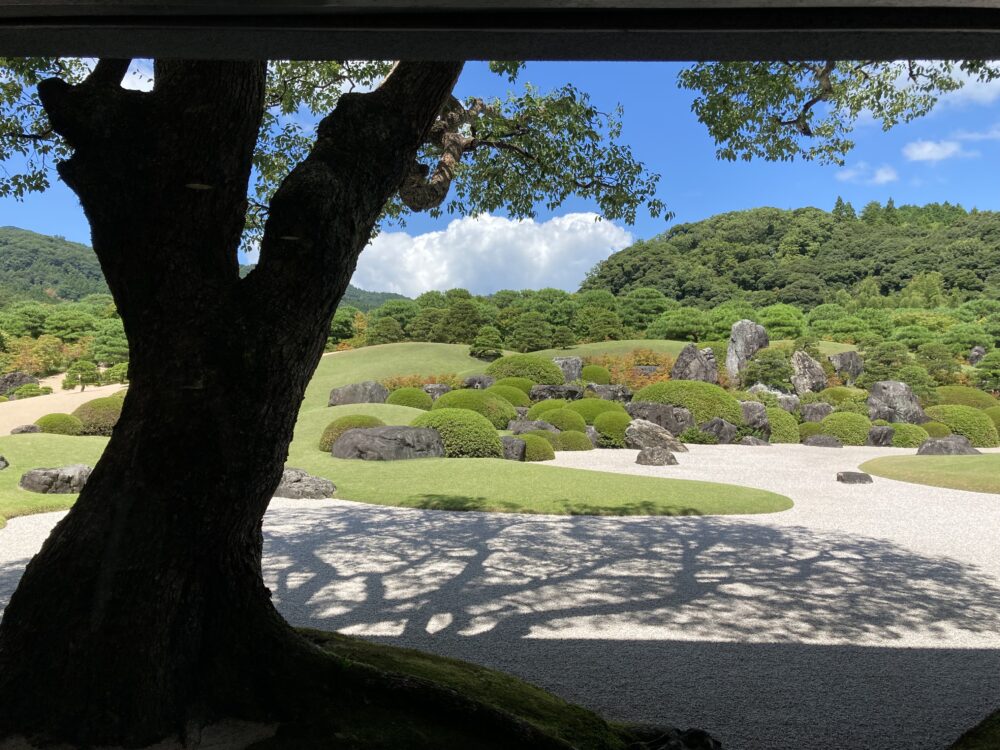
White Gravel and Pine Garden
This garden was inspired by Yokoyama Taikan’s painting Hakusa Seisho (“White Sand and Pine Trees”). The balanced placement of black pines on the white sand gives the space a calm, dignified beauty.
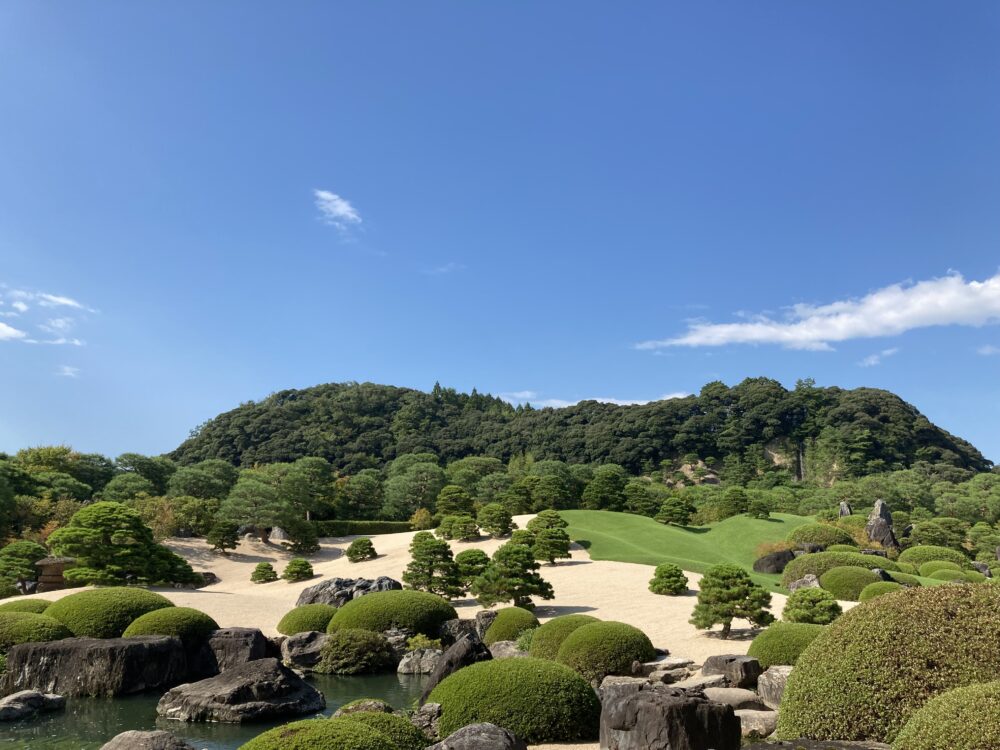
Pond Garden
The pond is fed by natural spring water, keeping it at a steady temperature year-round. This means the koi fish are lively and active even in winter.
The reflection of the sky and trees on the water’s surface looks just like a traditional landscape painting.
Immerse Yourself in the World of Yokoyama Taikan
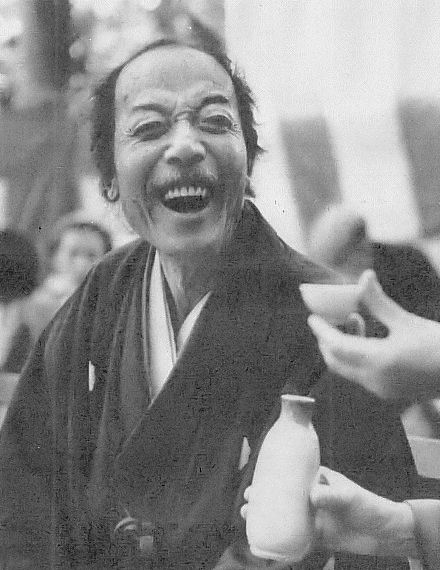
While the garden is the star attraction at the Adachi Museum of Art, the museum’s art collection is also incredibly impressive.
Founder Adachi Zenko spent his life building the collection, which now holds around 2,000 works. It covers a wide range of Japanese art, including paintings, sculpture, and ceramics. You could easily spend hours here exploring the world of traditional Japanese aesthetics.
The highlight of the collection is undoubtedly the works of Yokoyama Taikan, a legendary master of modern Japanese painting. With more than 130 of his pieces, the museum houses the largest and most comprehensive Taikan collection in Japan.
Here are a couple of standout works from the collection.
Autumn Leaves (1931)

Dimensions: 163.3 × 361.0 cm per screen
Taikan’s Autumn Leaves is nothing short of breathtaking. Or rather, we should say “screens”—since it’s a pair of folding screens forming one massive composition. Together, they stretch about 160 cm high and over 7 meters wide. Photos can’t do it justice; the scale must be experienced in person.
Originally planned as an ink painting with gold pigment, the artist changed direction midway after discovering a high-quality vermilion pigment in Kyoto. The result is a rich, colorful piece with bold contrasts.
The fiery red leaves pop against the cool blue of the river—complementary colors that immediately grab your attention. But Taikan’s true genius lies in the balance and subtlety.
The composition harmonizes warm oranges and greens, while the silver-white highlights of the river splashes create a sense of depth and movement on the right side of the screen.
Your eyes naturally follow the scene from left to right, finally landing on a small bird—likely a wagtail—taking flight from the river’s edge. In that moment, it feels like you’re right there in the scene, catching a fleeting moment in time.
It’s a colorful and luxurious painting, yet it has a refreshing stillness—like nature caught in a single, gentle breath.
White Sand and Pine Trees (1937)
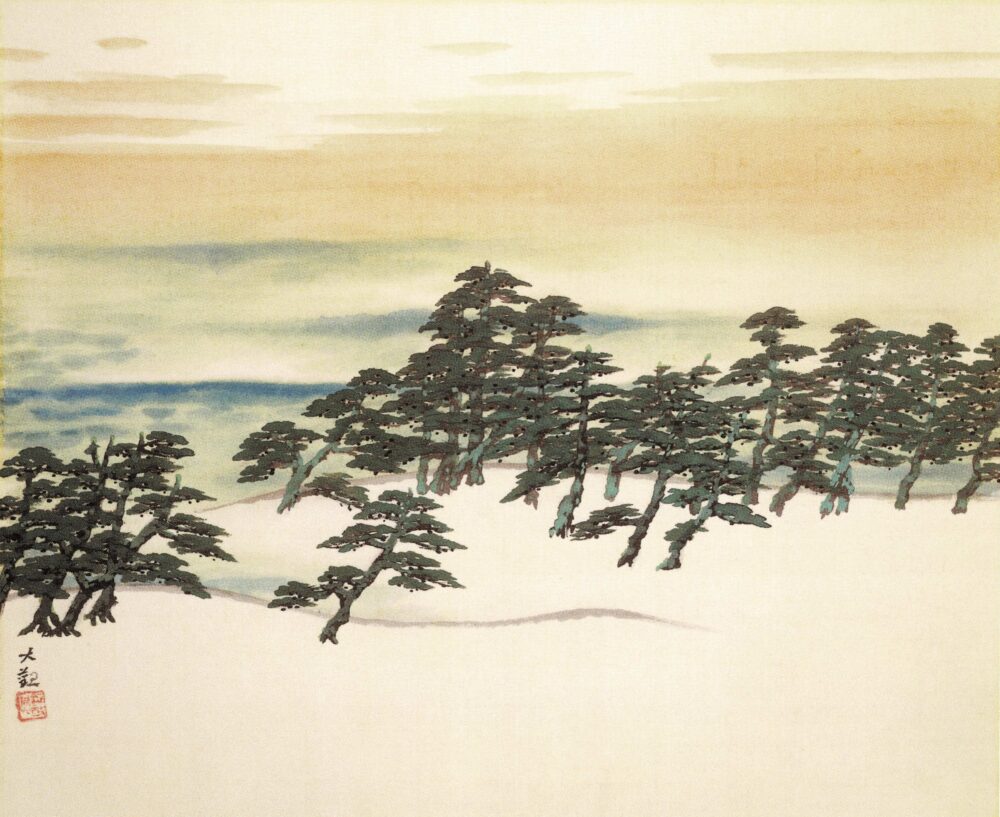
Have you ever heard the phrase “White Sand and Pine Trees”?
It describes a classic Japanese coastal scene: white beaches dotted with lush green pine trees.
These pines are known for their strength—able to thrive even in harsh seaside conditions where other plants can’t grow. Historically, they were planted along shores as natural windbreaks and barriers against waves.
In this painting, however, the pine trees aren’t arranged in neat, symmetrical rows. They appear scattered, windswept, and natural—growing wild and free.
Taikan captures this untamed beauty with a quiet intensity. Some trees lean slightly, as if swaying in the wind. There’s no artificial order here—just the raw elegance of nature.
The composition may seem simple at first glance, but it holds a quiet power. Each viewing reveals something new, making this a deeply contemplative work.
Nachi Falls (1915)
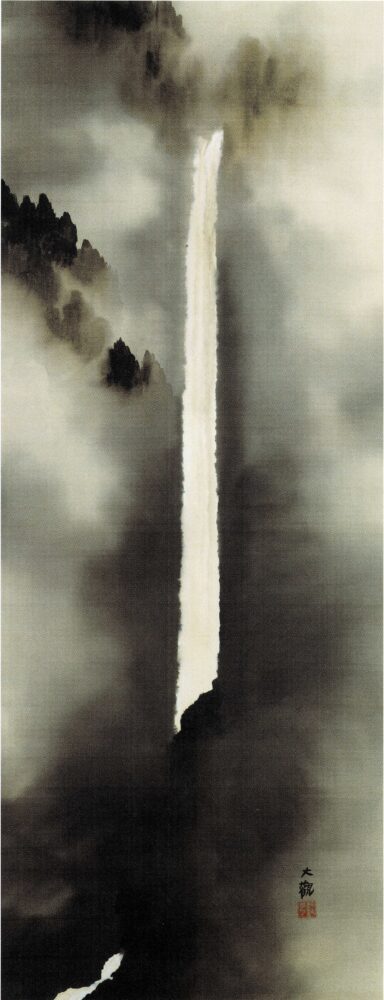
The last piece we’ll introduce is Nachi Falls, one of the most memorable paintings at the Adachi Museum of Art—and the inspiration for the garden’s Kikaku Waterfall.
The painting depicts the famous Nachi Waterfall in Wakayama Prefecture. At 130 meters (about 426 feet), it’s one of Japan’s tallest waterfalls and part of the UNESCO World Heritage Site “Sacred Sites and Pilgrimage Routes in the Kii Mountain Range,” designated in 2004.
Taikan’s version of Nachi Falls is striking in its simplicity. The waterfall is shown as a single white line cutting through dark cliffs, all painted using only ink in varying shades. While the surrounding trees are blurred and hazy, the waterfall stands out clearly, straight and strong.
It’s a mystical, almost divine scene—quiet yet powerful. You’ll find yourself wondering how a single ink painting can create such depth and emotion.
Strong, serene, unforgettable—this is one painting you won’t want to miss.
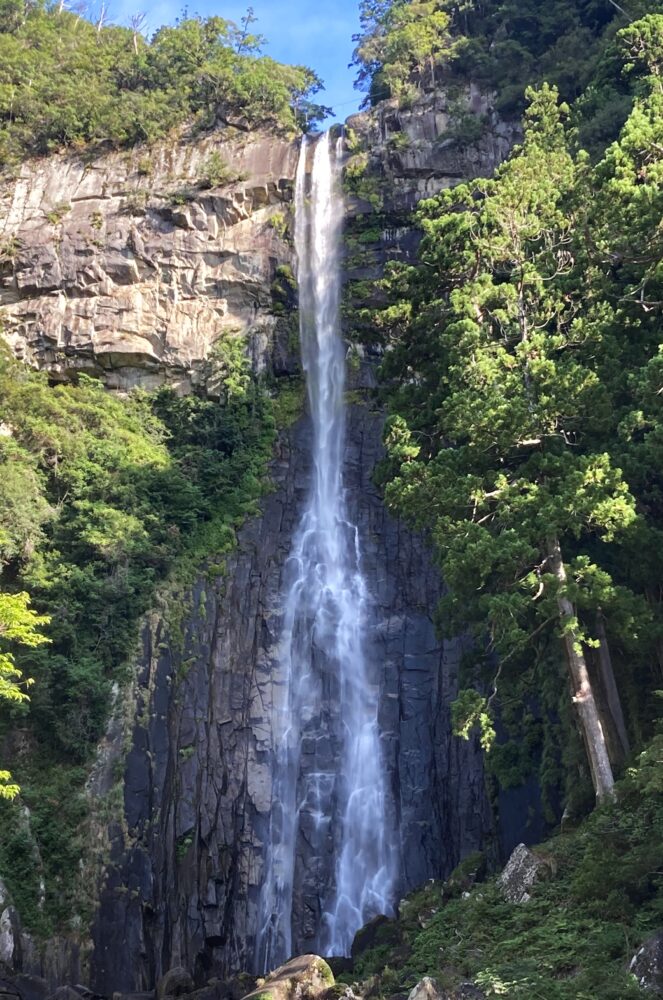
Final Thoughts: A Place to Experience the Beauty of Stillness
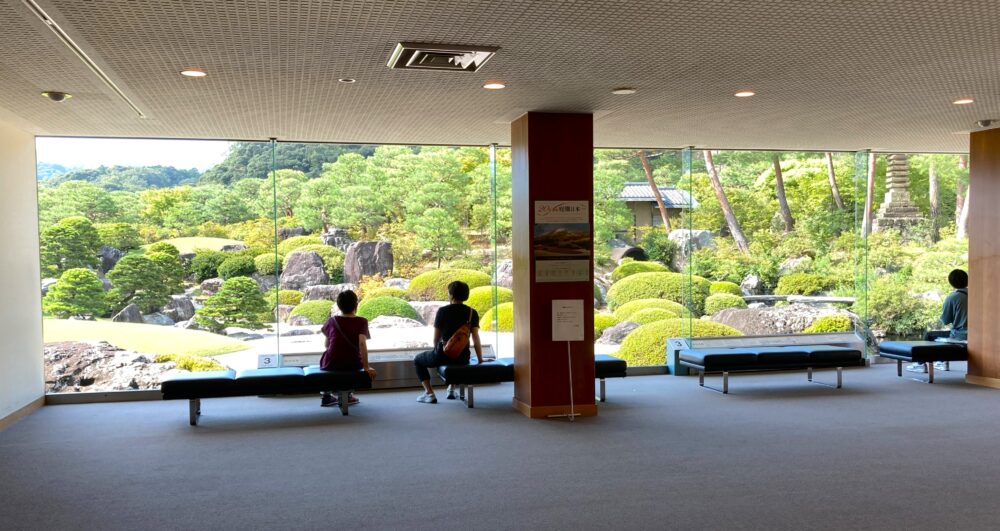
Because of its impressive collection of over 130 works by Yokoyama Taikan, the Adachi Museum of Art is sometimes referred to as the “Taikan Museum.”
It even has a dedicated gallery space just for his works, showing the importance of Taikan’s presence in the museum.
Some people may think traditional Japanese painting (Nihonga) seems a bit difficult to understand. But when you view these paintings while overlooking the peaceful gardens, their beauty starts to make perfect sense—without needing any explanation.
Yokoyama Taikan once said:
“It’s difficult to paint nature exactly as you see it. You store it in your memory, and over time, only the most beautiful impressions remain. When you paint those impressions, the result may not match the original scene—but your unique style will show through.”
(From Adachi Museum Taikan Selection, Adachi Museum of Art, 2021, p.138)
In other words, he didn’t just paint what he saw with his eyes—he painted what he felt in his heart.
This idea closely aligns with the spirit of Japanese gardens: rather than adding too much or decorating excessively, the goal is to bring out the natural beauty of the landscape.
At the Adachi Museum of Art, these two quiet forms of beauty—gardens and paintings—exist side by side, enhancing each other.
The garden’s stunning beauty is reason enough to visit, but what makes the experience truly special is being able to enjoy Japanese art while looking out onto that same landscape.
Since the museum rotates its exhibitions, there’s no guarantee you’ll see a specific painting on your visit. But the garden changes with the seasons, so no matter when you come, you’ll discover something new.
Whether you’re interested in Japanese art, love gardens, or simply want a peaceful escape—
the Adachi Museum of Art is a destination well worth your time.
Visitor Information: Adachi Museum of Art
Location: 320 Yokawa-cho, Yasugi City, Shimane Prefecture, Japan
References
- Adachi Museum of Art Curatorial Department (Ed.). Selected Works of Yokoyama Taikan at the Adachi Museum of Art. Adachi Museum of Art Foundation, Published March 6, 2021.
- Adachi Museum of Art (Author/Editor). ART GALLERY BOOKS: Adachi Museum of Art. Jitsugyo no Nihon Sha, Published November 20, 1986.











Comments